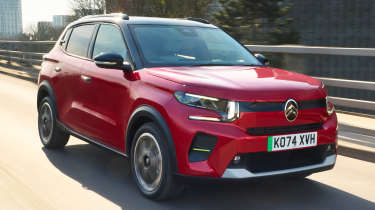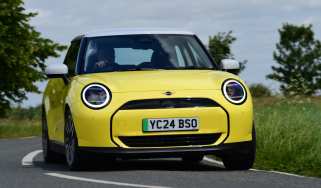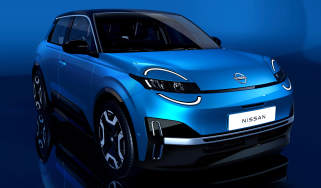Citroen e-C3 review – the right car at the right time


When it comes to buying your next car, finding one that’s cheap-to-run is usually a top priority. After all, it's not just the price at the dealership that matters – it’s the ongoing costs of ownership that can make or break a vehicle’s affordability. From fuel economy and servicing to insurance and tax, there’s a lot to consider when looking for a car that won’t drain your bank account.
Thankfully, you’re not short of budget-friendly options in today’s car market. We’ve picked the top 10 models that offer some of the most affordable driving across a range of sizes, from city cars to SUVs. There are petrol, diesel, hybrid, plug-in hybrid and electric options on this list, all of which deliver rock-bottom running costs.
Deciding which fuel type is best for you is the first step towards finding a cheap-to-run car. Pure petrol cars are usually the cheapest to buy and will return respectable fuel economy around town. Diesels are few and far between these days, but the ones that remain prove their worth on long motorway journeys, often delivering upwards of 60mpg.
Self-charging hybrids and plug-in hybrids make a lot of sense for those who mainly stick to urban driving, with the ability to cover some distance using no fuel at all. Of course, an electric car means you have no petrol bill whatsoever, but there’s the electricity cost to consider instead. If you’re able to charge at home or at work, this can bring huge savings thanks to affordable energy prices. If you’ll be relying solely on the expensive public charging network, an EV won’t be your best bet – in fact, it could cost more to run than a petrol car.
No matter your budget or lifestyle, this list is packed with cars that combine affordability, efficiency, and practicality. So, whether you’re commuting daily or simply looking to save on your annual motoring expenses, there’s bound to be a car here that suits your needs.
The Citroen e-C3 absolutely nails the cheap-to-run brief. It’s a fully-electric supermini, packing a 44kWh battery that can deliver up to 199 miles of range – more than plenty for most drivers. Charge it at home, and it’ll cost you pennies to run per mile, while other running costs won’t break the bank either. Servicing plans are cheaper for the e-C3 than other petrol-powered Citroens as there are fewer moving parts to worry about.
What really sets the e-C3 apart is the purchase price. Starting from just under £22,000, it's one of the most affordable electric cars on the market, and only around £4,000 more than its petrol twin, the Citroen C3. Sure, there may be even more affordable EVs out there, like the Dacia Spring and Leapmotor T03, but neither are as big and spacious as the Citroen. It really is an excellent supermini that delivers fantastic value for money, and the ultra-low running costs are an added bonus.
| Pros | Cons |
|
|
Not everyone is able to charge an electric car at home, so a hybrid will be the next best thing for many car buyers. The Renault Clio E-Tech might just be the best hybrid supermini around, especially for those wanting to cut their running costs. Firstly, it’s cheap to buy, starting from under £22,000, while Renault also offers some affordable PCP financing deals from as little as £160 a month. It comes equipped with an automatic gearbox and will return over 67mpg – a very impressive number for a car as refined and spacious as the Clio.
If you’re happy to spend a bit extra on fuel in order to save on the upfront cost of the Clio, you can opt for the entry-level petrol model instead. This uses a 1.0-litre three-cylinder engine with 89bhp and can return up to 54mpg. It can’t match the E-Tech hybrid for economy – or performance – but it’ll be more than adequate for many buyers. Plus, it’s the cheaper of the two to insure. An added bonus for the Clio is affordable servicing through the brand’s ‘Easylife’ plans.
| Pros | Cons |
|
|
Another hybrid supermini, this time from British-Chinese firm MG. The MG3 was reborn last year as a self-charging hybrid hatchback, packing some cutting-edge tech to make it one of the most efficient cars on the market. The 1.5-litre engine and electric motor combine to return up to 64mpg – we saw an average of 55mpg during our testing across a mixture of roads, which isn’t miles off the official figure.
There are other hatchbacks that can match that figure, but the MG3 has a couple of tricks up its sleeve. With 192bhp, it’s surprisingly quick, easily outperforming most economy-focused superminis. But more importantly, the MG3 is super affordable, costing from just £18,500. That’s the same as the basic petrol-powered Clio, despite all of the MG’s high-tech hybrid gubbins. It’s well-equipped, too, but be warned that it’s not the most practical hatch out there. Insurance costs are also a bit higher than rivals – it sits in group 23 out of 50.
| Pros | Cons |
|
|
The Skoda Octavia is a favourite among families looking for frugal motoring without compromising on quality. The large boot, extensive equipment list and sturdy interior mean car buyers won’t feel like they are missing out on much compared with more expensive options. The Octavia’s size makes it closer to competitors in the class above for practicality, too, giving it an advantage over the Volkswagen Golf it’s based on.
Despite its size, the Octavia is cheap to run, no matter which engine you pick. The most frugal is the entry-level diesel engine; a 2.0-litre with 114bhp. It’ll return up to 66mpg, while the more powerful 148bhp version of the same engine is capable of returning over 60mpg with the added benefit of a DSG automatic gearbox. Even the 1.5-litre, 148bhp petrol engine can manage over 50mpg, with DSG-equipped models getting mild-hybrid assistance.
It’s a shame that Skoda didn’t renew the plug-in hybrid Octavia after its 2024 facelift, but the remaining petrol and diesel models are still some of the cheapest family cars to run. It’s both cheaper to buy and insure than a VW Golf, as well – both factors that earned it the Carbuyer Best Family Car award for 2025.
| Pros | Cons |
|
|
The current generation of Hyundai’s dinky city car, the i10, has been on sale since 2020, but it’s still one of the best cheap-to-run cars you can buy. There’s no hybrid tech to speak of here, but the i10 earns its spot on this list by being small and light. The entry-level model gets a tiny 1.0-litre engine, helping it to return up to 53mpg. It does feel a bit out of its depth on the motorway, though, so we recommend stepping up to the 1.2-litre engine. It’s nearly as economical but is much more at home on faster roads.
The Hyundai i10 solidifies its spot on this list by being one the cheapest cars to insure in the UK. It sits in the lowest insurance group of them all, something that will be especially important for young or new drivers. Don’t forget that the i10 costs from just £16,000, making it the cheapest car to buy on this list, while still feeling reasonably spacious and well-equipped on the inside.
| Pros | Cons |
|
|
The Toyota Yaris is all about fuel economy. With dinky dimensions and a small 1.5-litre engine, it will return up to 70mpg – the largest figure on this list. Even in our testing, we saw an average of 65mpg across different roads, with that number increasing during around town driving. That’s down to the clever, standard-fit hybrid system that Toyota has been continuously developing since the original Prius launched in 2000. For city dwellers who aren’t ready for an EV, the Yaris could be an excellent choice.
The Yaris is shorter and narrower than some of its supermini rivals, including the Renault Clio and MG3, so it’s not the one to go for if you need a big boot or plan to carry multiple passengers regularly. There’s always the Toyota Yaris Cross if you do need something a bit more practical – it’s essentially the same as the regular Yaris but sports a chunkier SUV body for more space. It’s also worth mentioning Toyota’s industry-leading 10-year, 100,000-mile warranty. You need to service your car at an official dealer to qualify, but doing so unlocks a decade of cover, so you won’t be shocked by any big, nasty bills.
| Pros | Cons |
|
|
The MG4 was somewhat of a game-changer when it arrived in 2022. It was one of the first affordable all-electric hatchbacks, costing less to run than petrol and diesel-powered rivals like the Volkswagen Golf and Ford Focus. In 2025, it still holds up, with an affordable price tag and impressive specs, despite the swathe of new EVs that have arrived over the past three years.
There are four versions of the MG4, and all feel broadly similar in terms of performance (besides the most expensive, 429bhp XPower model) but range will be of more importance to most buyers. The standard car manages 218 miles from its 51kWh battery – we think that makes the most sense for buyers after a cheap-to-run car, as most drivers don’t do much more than 20 miles a day on average. There are Long Range and Extended Range models, too, upping range to 281 miles and 323 miles, respectively.
All versions of the MG4 come with 150kW DC rapid charging, too, so a 10-80% top-up will take just half an hour. Despite being a budget-friendly EV, the MG4 also feels well-equipped and modern, albeit with some lower-quality pieces of trim. When it comes to running costs and value for money, though, the MG4 is hard to beat.
| Pros | Cons |
|
|
Few cars offer a value proposition quite like the Dacia Jogger. It offers everything a large family could need – primarily, seven seats – for a sub-£20,000 price tag that’s hard to believe. Importantly, it’s cheap to run – the entry-level 1.0-litre three-cylinder petrol engine will return up to 49mpg, a figure that we found to be pretty accurate during our testing. Sure, there are very few frills to be found in the base Jogger’s cabin, but if you need an affordable seven-seater, there’s no better place to look.
If you’re willing to splash a bit more cash, you can get the Jogger with the same 1.6-litre full-hybrid engine as the Clio E-Tech. The system works just as well in this application, returning up to 59mpg despite the added bulk of the MPV bodywork. We found it easy to achieve over 50mpg during our in-depth test without needing to be overly careful, so we have no doubt the Jogger will be an efficient family-hauling machine in the real world. The hybrid will cost you £4,000 more to buy than the regular petrol model, though, so it’s worth considering whether the fuel savings will cover that difference over the course of your ownership.
| Pros | Cons |
|
|
The Skoda Enyaq is great value compared to other electric SUVs and won’t break the bank to run. There are a few versions to choose from – the entry-level Enyaq 60 gets a 200bhp electric motor, with the 85 upping this to 282bhp, while the top-of-the-range 85x gets four-wheel drive thanks to dual motors. We think the cheapest 60 model with the 58kWh battery is the best pick, given its adequate range for most buyers – it’ll get up to 268 miles on a charge, so most drivers will only have to charge once a week.
One of the Enyaq’s biggest selling points is its practicality; there are few EVs to offer such a spacious interior and huge boot at this price point. There are lots of clever storage solutions around the cabin, and the doors and boot open to a wide angle for easy access. The electric SUV’s flat floor means there’s lots of legroom and the car’s tall, boxy shape means it gets a vast 585-litre boot which increases to 1,710 litres with the rear seats folded down – it’s one of the largest boots of any electric car on sale. The Enyaq has just been given a styling makeover for 2025, too, giving it a new lease of life in a crowded electric SUV market.
| Pros | Cons |
|
|
Offered as a hybrid, plug-in hybrid, and fully EV, the Kia Niro is certainly a cheap car to run. While the purchase price increases, the fuel bills keep dropping the higher up the Niro range you go. In standard hybrid form you can expect 60mpg, while the plug-in hybrid manages 40 miles on electric power alone – enough for most commutes, helping to cut your fuel bills. All models come with a seven-year/100,000 mile warranty, which helps keep any unforeseen costs at bay. However, the fully-electric model is currently assigned the same servicing regime as the hybrid and plug-in hybrid of 10,000 miles or annually, which adds costs that some may have hoped to save by going for the EV.
Overall, the Niro offers a spacious and well-equipped option for buyers looking for a hybrid or EV, although the plug-in hybrid loses some boot space, so check to make sure you get the one that best suits your needs.
| Pros | Cons |
|
|
Take a look at the table below for a full run-down of the pricing and Carbuyer scores of our top 10 best cheap-to-run cars.
| Best cheap-to-run car | Make and model | Priced from | Carbuyer rating (out of 5) |
| 1 | Citroen e-C3 | £22,000 | 4.2 |
| 2 | Renault Clio | £19,000 | 4.4 |
| 3 | MG3 | £19,000 | 4.3 |
| 4 | Skoda Octavia | £27,000 | 4.7 |
| 5 | Hyundai i10 | £16,000 | 4.0 |
| 6 | Toyota Yaris | £23,000 | 4.0 |
| 7 | MG4 | £27,000 | 4.3 |
| 8 | Dacia Jogger | £18,000 | 4.0 |
| 9 | Skoda Enyaq | £37,000 | 4.5 |
| 10 | Kia Niro | £30,000 | 4.3 |
Why not read our list of the best family cars, too?

New Toyota RAV4 to double down on hybrid power and rugged styling

Best car leasing deals 2025: this week’s top PCH offers

New Nissan Micra is a Renault 5 in Nissan clothing


